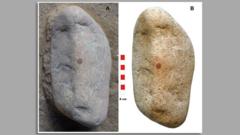Scientists in Spain have made an intriguing discovery that may alter our perception of Neanderthals as primitive beings. A recent excavation at the San Lázaro rock shelter in Segovia has unearthed a rock featuring the oldest complete human fingerprint attributed to a Neanderthal, dating back approximately 43,000 years. The rock bears a red pigment dot that resembles a human face, leading researchers to propose that Neanderthals could have engaged in artistic endeavors.
The scientific investigation suggests that a Neanderthal man dipped his finger in red pigment to create a nose on the pebble, positioning the dot strategically to enhance its representation. Co-author of the study, María de Andrés-Herrero from the University of Complutense in Madrid, emphasized the significance of this find in the ongoing discourse surrounding Neanderthals' capabilities for abstract thought and symbolic behavior.
Excavation efforts started five years ago, and in 2022, the team discovered the stone beneath 1.5 meters of sediment from the Neanderthal period. Initially, the unique form of the stone, larger compared to others from the site, surprised the researchers when they noticed a red dot in its center. Following extensive analysis, including multi-spectrum evaluation, they confirmed the presence of both the pigment and a male adult fingerprint.
Despite the intriguing nature of the fingerprint, archaeologist David Álvarez Alonso acknowledged the challenges in definitively attributing the print to a specific Neanderthal due to the lack of existing references for comparison. Spanish official Gonzalo Santonja noted that this painted pebble is the oldest known portable art object in Europe, marking a crucial milestone in understanding Neanderthal artistry.
Prof de Andrés-Herrero pointed out that this finding is significant, as it represents the first pigment-marked object found in a distinct archaeological context directly linked to Neanderthals. The absence of natural red pigment in the area bolsters the claim that the ochre stain was purposefully applied to convey meaning or artistic intent.
As researchers continue to investigate the implications of this discovery, they assert that the stone's visual characteristics merit recognition as a symbol of art from a time long past. The study results have been published in the journal Archaeological and Anthropological Sciences.



















